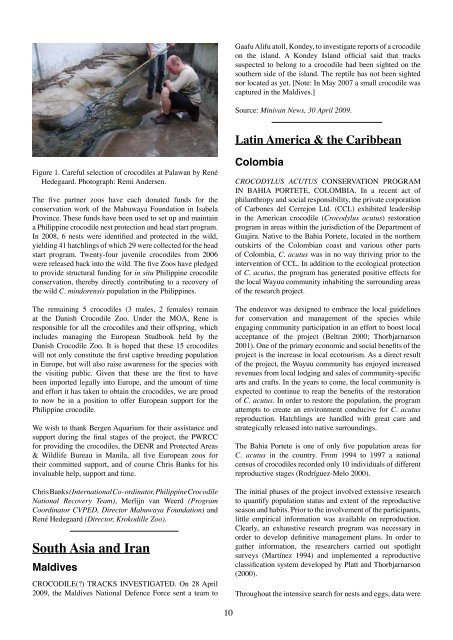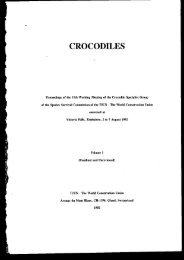CROCODILE SPECIALIST GROUP NEWSLETTER
CROCODILE SPECIALIST GROUP NEWSLETTER
CROCODILE SPECIALIST GROUP NEWSLETTER
Create successful ePaper yourself
Turn your PDF publications into a flip-book with our unique Google optimized e-Paper software.
Gaafu Alifu atoll, Kondey, to investigate reports of a crocodile<br />
on the island. A Kondey Island official said that tracks<br />
suspected to belong to a crocodile had been sighted on the<br />
southern side of the island. The reptile has not been sighted<br />
nor located as yet. [Note: In May 2007 a small crocodile was<br />
captured in the Maldives.]<br />
Source: Minivan News, 30 April 2009.<br />
Latin America & the Caribbean<br />
Figure 1. Careful selection of crocodiles at Palawan by René<br />
Hedegaard. Photograph: Remi Andersen.<br />
The five partner zoos have each donated funds for the<br />
conservation work of the Mabuwaya Foundation in Isabela<br />
Province. These funds have been used to set up and maintain<br />
a Philippine crocodile nest protection and head start program.<br />
In 2008, 6 nests were identified and protected in the wild,<br />
yielding 41 hatchlings of which 29 were collected for the head<br />
start program. Twenty-four juvenile crocodiles from 2006<br />
were released back into the wild. The five Zoos have pledged<br />
to provide structural funding for in situ Philippine crocodile<br />
conservation, thereby directly contributing to a recovery of<br />
the wild C. mindorensis population in the Philippines.<br />
The remaining 5 crocodiles (3 males, 2 females) remain<br />
at the Danish Crocodile Zoo. Under the MOA, Rene is<br />
responsible for all the crocodiles and their offspring, which<br />
includes managing the European Studbook held by the<br />
Danish Crocodile Zoo. It is hoped that these 15 crocodiles<br />
will not only constitute the first captive breeding population<br />
in Europe, but will also raise awareness for the species with<br />
the visiting public. Given that these are the first to have<br />
been imported legally into Europe, and the amount of time<br />
and effort it has taken to obtain the crocodiles, we are proud<br />
to now be in a position to offer European support for the<br />
Philippine crocodile.<br />
We wish to thank Bergen Aquarium for their assistance and<br />
support during the final stages of the project, the PWRCC<br />
for providing the crocodiles, the DENR and Protected Areas<br />
& Wildlife Bureau in Manila, all five European zoos for<br />
their committed support, and of course Chris Banks for his<br />
invaluable help, support and time.<br />
Chris Banks (International Co- ordinator, Philippine Crocodile<br />
National Recovery Team), Merlijn van Weerd (Program<br />
Coordinator CVPED, Director Mabuwaya Foundation) and<br />
René Hedegaard (Director, Krokodille Zoo).<br />
South Asia and Iran<br />
Maldives<br />
<strong>CROCODILE</strong>(?) TRACKS INVESTIGATED. On 28 April<br />
2009, the Maldives National Defence Force sent a team to<br />
Colombia<br />
CROCODYLUS ACUTUS CONSERVATION PROGRAM<br />
IN BAHIA PORTETE, COLOMBIA. In a recent act of<br />
philanthropy and social responsibility, the private corporation<br />
of Carbones del Cerrejon Ltd. (CCL) exhibited leadership<br />
in the American crocodile (Crocodylus acutus) restoration<br />
program in areas within the jurisdiction of the Department of<br />
Guajira. Native to the Bahia Portete, located in the northern<br />
outskirts of the Colombian coast and various other parts<br />
of Colombia, C. acutus was in no way thriving prior to the<br />
intervention of CCL. In addition to the ecological protection<br />
of C. acutus, the program has generated positive effects for<br />
the local Wayuu community inhabiting the surrounding areas<br />
of the research project.<br />
The endeavor was designed to embrace the local guidelines<br />
for conservation and management of the species while<br />
engaging community participation in an effort to boost local<br />
acceptance of the project (Beltran 2000; Thorbjarnarson<br />
2001). One of the primary economic and social benefits of the<br />
project is the increase in local ecotourism. As a direct result<br />
of the project, the Wayuu community has enjoyed increased<br />
revenues from local lodging and sales of community-specific<br />
arts and crafts. In the years to come, the local community is<br />
expected to continue to reap the benefits of the restoration<br />
of C. acutus. In order to restore the population, the program<br />
attempts to create an environment conducive for C. acutus<br />
reproduction. Hatchlings are handled with great care and<br />
strategically released into native surroundings.<br />
The Bahia Portete is one of only five population areas for<br />
C. acutus in the country. From 1994 to 1997 a national<br />
census of crocodiles recorded only 10 individuals of different<br />
reproductive stages (Rodríguez-Melo 2000).<br />
The initial phases of the project involved extensive research<br />
to quantify population status and extent of the reproductive<br />
season and habits. Prior to the involvement of the participants,<br />
little empirical information was available on reproduction.<br />
Clearly, an exhaustive research program was necessary in<br />
order to develop definitive management plans. In order to<br />
gather information, the researchers carried out spotlight<br />
surveys (Martínez 1994) and implemented a reproductive<br />
classification system developed by Platt and Thorbjarnarson<br />
(2000).<br />
Throughout the intensive search for nests and eggs, data were<br />
10
















